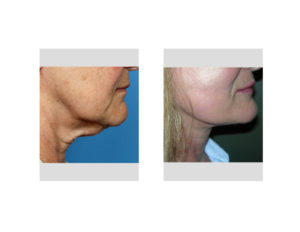
In the January 2017 issue of the Aesthetic Surgery Journal, a paper was published entitled ‘Subplatysmal Necklift: A Retrospective Analysis of 504 Patients’. In this well illustrated paper the authors go through a step by step surgical approach to all of the reachable subplatysmal structure and report their results on a very large patient series. Through a low submental incision (3 cms from the natural submental skin crease), all subplatysmal neck structures could be well visualized particularly the submandibular glands. The sequence included the initial removal of interplatysmal fat and elevation of the medial borders of the platysma muscle. The submandibular glands were located by following the anterior border of the digastric muscle to the hyoid bone. The gland capsule was opened and the medial half of the gland removed. Botox injections (10 units) were placed into the remaining gland and the gland capsule closed with continuous sutures. If indicated a subtotal resection of the anterior belly of the digastric muscle is also done. Hyoid repositioning can be performed by suture plication of the peri-hyoid fascia at the level of the pulleys of the digastric muscles. Lastly, a corset platysmaplasty is done.
A total of over 500 patients underwent this type of subplatysmal necklift. Not all patients had every subplastysmal structure treated with the most common being fat (84%), the submandibular glands (61%) and the digastric muscle. (18%) Complications included temporary weakness of the marginal mandibular nerve (6%) and salivary leak from the gland (2%) No hematomas or infection occurred.
Modification of the subplatysmal structures in neck contouring can include fat, the anterior bellies of the digastric muscles, the submandibular glands and the hyoid bone. Historically subplatysmal neck contouring has been avoided due to concerns of facial nerve injury and creating a salivary gland leak. This paper demonstrates that, while these complications do occur, they do not so at a high rate. Furthermore they are self-resolving issues without permanent sequelae.
This paper demonstrates that the subplatysmal necklift is a safe and effective neck contouring approach. It goes beyond the traditional neck contouring methods of subcutaneous neck liposuction and plastyma muscle plication. For those indicated patients it does improve volume reduction and creates subplatysmal support that the platysmal muscle alone can not do.
Dr. Barry Eppley
Indianapolis, Indiana


